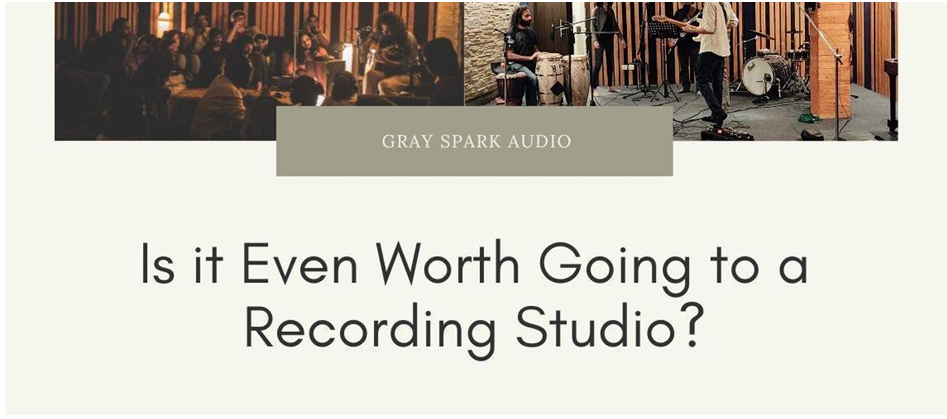
Is it even worth going to a recording studio
Is it even worth going to a recording studio in 2022 when you have the luxury for recording everything in your bedroom or so you think
Studios are fun. You can also find out free music production courses online where you can get a crash course of mixing mastering and how important is studio for recording.
Studios usually have nice and cozy interiors, nice people (if people aren’t welcoming and nice the studio would have a hard time running), big screens, nice shiny microphones and lots of black buttons, levers, VU meters , lights. Yes, even better than Star Trek!
Not to mention the seemingly limitless supply of coffee, tea, cookies and chewing gums (don’t ask).
Unfortunately, studios are also expensive.
Maybe not very expensive, but definitely more expensive than recording at home. At the time, even with skill and knowledge, it was nearly impossible to achieve commercial quality with a “homemade” kit. The kit is not good enough. You have noisy preamps with low gain, problematic recording media (music cassettes, anyone?), good microphones that are practically impossible to buy, etc.
All of this makes domestic products more recognizable and inferior to commercial products. Also, of course, for most people it was completely impossible to start small production of the most “professional” playback medium at the time – a vinyl record.
Don’t forget to distribute and sell to listeners. This is absolutely not the case these days. The unspoken promise of today’s equipment is yes, you can do it at home and it will sound just as good as it does in the studio. And indeed it is.
We have great mics for pretty cheap. We have excellent clean preamps with a wide range of benefits in most audio interfaces. Digital recording with an inexpensive all-in-one PC for everyone, translates your precious music into recording media with pristine quality and more dynamic range you can use, super easy to deliver and for sale (if you see anyone interested, of course!). We have the best signal processing plugins at your fingertips, once the domain of extremely expensive, low-cost, and near-unlimited hardware processors. The list is long.
All of this makes it possible to create amazing works at home that are completely indistinguishable from commercial products. Indeed, today, many commercial productions are made in home studios, also by names that can easily fund serious study sessions.
There is of course a question of jurisdiction. Skills cannot be bought with money, but with enough determination and focus, you can absolutely follow the rope and be very successful. After all, helping with skills is the main reason I write this blog.
That said, the question remains: is there still room for recording studios? Well.
Looking at the number of studios in the world and the number of people actively using them, it is clear that the answer is much less space than it used to be. Commercial studios are almost extinct, only the larger ones are still operating and are often supported by side businesses or simply seen as a cost factor by much larger businesses. Many boutique studios are run more like a side business than a serious business.
So let’s say it again: is there still a reason for you to get into the studio?
It depends a lot on how you make music and why. That said, however, the surprising answer may still be “yes”.
First of all (since these days the quality of the kits you can use at home is generally comparable to the kits you find in the studio), there is still an aspect to which recording studios are built.
Having good intentions still has a technical advantage. very difficult (and very expensive) to replicate elsewhere.
And that is the quality and ease of use of its recording and mixing spaces. We already know that to make a good recording, the quality of the recording space is only as important as the quality of the performance. And the thing is, most of the time the best thing you can do with a home studio is pick a bad room and add some audio processing to make it better.
Now: Done, this can give you a really great sounding room where reflections are somewhat controlled – and customizable – for both recording and mixing.
(Note: customizing the audio processing is important. For example, it’s good enough to have some degree of natural reverberation when recording guitars, but the same kind of reverb can kill. In the HQ mixer, everything is as dry as it can be, so what you hear is your mix, not the room you’re in).
Sound processing, however, is not the easiest thing to do. This may not be possible at all if said room is also used, for example by your partner, or as a guest bedroom, or as a play area for your children. The sound processing is clunky and pretty obvious (one trick I use is that all textiles are wall-white..) so it can simply be difficult to keep it permanently installed. fixed on your walls and ceilings.
The rooms in a typical house also tend to be square, quite small, and have relatively low ceilings. They hold furniture, pipes and things that you can’t move sometimes. It is possible, but it is not so easy to consider such a work to be really, really good. If the room is quite small, this may not be possible.
Of course, you can certainly find a good compromise, and by getting into the habit of taking dry notes, you can certainly get very good results. It’s worth mentioning that some sources work better than others: for example, it’s much easier to record vocals and guitars in a home studio than a mic in a bass cabinet; and conversely, it’s nearly impossible for some devices to record
indoors – both because of the average room size and the noise levels involved. I recorded the practice drums in my living room once, but that’s not something I want to do often (the room is large and has fairly high ceilings, but moving all the furniture aside isn’t fun). and we have to make sure we’re done by the time the neighbor gets home from work!).
But overall, it takes effort, skill and attention, and the possibility of error is always lurking. It’s all a bit distracting from making music, especially if you don’t like the technical details.
This is not a common problem in a good studio. A good studio will often have purpose-built rooms, often a room-in-a-room design that shapes, covers, and treats the sound (including things like room-in-room and sets. resonance between walls) are all designed together to give you reflections or easy customization. The mixer seat will be as dry as usual and monitoring will not be affected by reflections.
And of course, any self-respecting studio has a room big and tall enough to allow you to record drums in all their glory! Drum sets recorded in small rooms tend to sound small. Also, in a real studio, you walk in, put the microphone where you like the sound, and push the recording.
Recording quality is generally good enough without too much effort. The only thing that matters to the result is the absolute quality of the artist’s performance, as it should be.
I write studio “good” because of course you have to remember that there are “studios” that are just a few kits and absorbers installed in a common room
In these cases, you really have to use your ears to literally decide if you’re being asked to pay for thin air…and often opt to record at home instead.
Overall, the above is the only technical reason to go to the studio these days. It boils down to the size, shape and acoustics of your recording space. That’s essentially what you pay for.
There are also some non-technical reasons.
Most obviously, a good studio will have someone qualified to handle the operational aspects of recording for you. Both are important factors. As anyone who has read this blog knows, recording is not just about putting a mic in front of the source and doing your best. Skills are a big part of the quality of results today, much more important than equipment. Also, obtaining a certification is expensive. Qualification comes at a price of time, mistakes, and trial and error. So if you don’t really like the recording process (like me for example), you might be better off spending some money to take advantage of someone else’s skills. Also note that even in the age of the Internet, talking face-to-face with an expert is a very good way to learn. Once in the studio, you can greatly improve your skills as long as you can hang out and work with the resident engineers and other sound engineering colleges in India.
As noted above, beware of makeshift “studio” owners who actually have equipment in their rooms. Having egg cartoons on the wall is a dead giveaway. So does the idea of using the sofa as a bust strap. Another factor that is often underestimated is having someone in charge of operating the equipment. The absolute pinnacle of recording is the performance, so if you are both a turntable and an artist, the ASIO buffer 100% if you have to think about reducing his size or increasing it by navigating with the mouse in your DAW It can be difficult to provide performance for Set the tracks for the new take.
How important this is is, of course, entirely up to you. There are many good things about recording at home. For example, no time pressure. Others believe that the relaxed environment of your home leads to a better gig than a studio with a crowd watching you. But if you’re always frustrated by the professionalism of your recordings, it’s a good idea to record in a good studio.
Then there’s efficiency. Studio technicians are always recording artists and instruments in the same room, so they know where in the room the mics are good for a particular recording, which mics are good for what, and how to set up the room. You can quickly find out which specific activity. This means less time rigging and more time making music.
Another often-underrated aspect of the studio visit is the networking element. Being in the studio allows you to meet other musicians and artists, as well as people who have some connection to other aspects of the music being released (label owners, engineers, etc.). First of all, it vastly improves your chances of learning something useful or touching gadgets you otherwise wouldn’t have seen. This gear isn’t necessary to make a good record, but it’s beautiful and inspiring.
Second, if your music is worth listening to (and it is! there’s no reason to do it any other way), more people will interact with it. It’s true that music distribution is based on subjective judgment, but in order to judge something, you need the opportunity to have people listen to it. Studios are often a good starting environment in this sense. Again, your personality and goals are important. If you’re super shy and don’t talk to anyone in the studio or have no interest in people listening to your music, that aspect doesn’t matter at all. But if not, it’s worth considering.
That’s it. It’s easy to see why the number of studios has plummeted in recent decades. With these factors in mind, take some time to decide if a recording studio is right for you. Especially if, as a musician, you find yourself frustrated and uninspired when delving into the technical aspects of recording, or if you want immediate results, the studio is a viable option. , rather worth investing in studio time. Better than room treatment, recording and mixing equipment.
Demos can always be done on your mobile phone
If you do go this route, make sure you pick a good spot, not something hastily invented by someone trying to capitalize on your enthusiasm. The key is to look beyond the attractive furnishings and room design.
This is where we come in as a recording studio and as an audio engineering school building upcoming audio engineers and music producers.



Average Rating